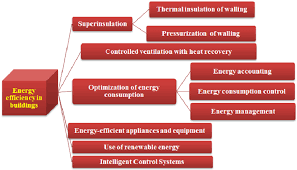Energy consumption and energy-saving systems and equipment
Energy consumption refers to the amount of energy used by various systems, devices, or equipment to perform their functions. Energy-saving systems and equipment, on the other hand, are designed to reduce energy consumption and promote energy efficiency. These systems and equipment employ various technologies and strategies to minimize energy waste and optimize energy usage. Here are a few examples:
- Energy-Efficient Lighting: This includes LED (Light Emitting Diode) and CFL (Compact Fluorescent Lamp) bulbs, which consume less energy compared to traditional incandescent bulbs while providing the same or better light output.
- Smart Thermostats: These devices allow users to control heating, ventilation, and air conditioning (HVAC) systems more effectively. They can adjust temperature settings based on occupancy patterns, optimize heating and cooling schedules, and learn user preferences to save energy.
- Energy Management Systems (EMS): EMS provide centralized control and monitoring of energy usage in buildings or industrial facilities. They collect data from various sensors and devices to analyze energy consumption patterns, identify inefficiencies, and optimize energy usage for lighting, HVAC, and other systems.
- Energy-Efficient Appliances: Many household appliances such as refrigerators, washing machines, and dishwashers now come with energy-saving features and are designed to meet energy efficiency standards. These appliances use advanced technologies to minimize energy consumption while maintaining performance.
- Renewable Energy Systems: Utilizing renewable energy sources such as solar panels or wind turbines reduces reliance on fossil fuels and decreases energy consumption from the grid. These systems generate clean energy and can even feed excess electricity back into the grid.
- Building Insulation: Proper insulation in buildings reduces heat transfer, making it easier to maintain comfortable temperatures without excessive heating or cooling. This reduces the energy needed to regulate indoor climate.
- Energy-Efficient Windows: Windows with low-emissivity (low-e) coatings, double or triple glazing, and insulated frames help to minimize heat transfer, reducing the need for heating or cooling.
- Energy Recovery Systems: These systems capture and reuse waste energy from industrial processes or ventilation systems. Heat exchangers, for example, can recover heat from exhaust air and use it to preheat incoming fresh air.
- Power Management Software: This software monitors and manages energy usage of computers and other electronic devices, optimizing settings to reduce power consumption during periods of inactivity.
- Energy-Efficient Transportation: Electric vehicles (EVs) and hybrid vehicles are more energy-efficient compared to traditional gasoline-powered cars. They utilize electric motors and advanced energy management systems to reduce energy consumption and emissions.
These are just a few examples of energy-saving systems and equipment. The development and adoption of such technologies play a crucial role in conserving energy resources and mitigating the impact of human activities on the environment.
When Energy consumption and energy-saving systems and equipment are used?
Energy consumption and energy-saving systems and equipment are used in various sectors and settings to manage and optimize energy usage. Here are some common applications:
- Residential Buildings: Energy-saving systems and equipment are widely used in homes to reduce energy consumption and lower utility bills. This includes energy-efficient appliances, smart thermostats, LED lighting, and home energy management systems. These technologies help homeowners track and control their energy usage, adjust settings for optimal efficiency, and save energy without sacrificing comfort.
- Commercial Buildings: Energy consumption in commercial buildings can be significant, and energy-saving systems and equipment are crucial for reducing costs and improving sustainability. Building automation systems, occupancy sensors, efficient HVAC systems, and LED lighting are commonly employed to manage energy usage in offices, retail spaces, hotels, and other commercial establishments.
- Industrial Facilities: Industries often consume large amounts of energy in their manufacturing processes. Energy-saving systems and equipment such as energy-efficient motors, variable speed drives, and optimized process controls help minimize energy waste and improve productivity. Energy management systems are also used to monitor and optimize energy usage across different processes within the facility.
- Transportation: Energy consumption in the transportation sector, particularly in vehicles, is a significant contributor to overall energy usage. Energy-saving systems and equipment are used in various ways, including hybrid and electric vehicles, efficient engines, regenerative braking systems, and aerodynamic designs. These technologies aim to reduce fuel consumption and emissions, promoting energy efficiency in transportation.
- Information Technology: Data centers and IT infrastructure consume substantial amounts of energy. Energy-saving systems and equipment in this sector focus on optimizing server efficiency, implementing virtualization technologies, employing efficient cooling systems, and using energy management software. These measures help reduce the energy footprint of data centers while maintaining reliable operation.
- Renewable Energy Systems: Energy-saving systems and equipment are used in renewable energy generation to maximize the efficiency of power production. Technologies such as solar trackers, wind turbine control systems, and energy storage systems help optimize the capture, conversion, and storage of renewable energy, ensuring efficient utilization.
- Public Infrastructure: Energy-saving systems and equipment are utilized in public facilities and infrastructure, including street lighting, public transportation systems, and wastewater treatment plants. LED streetlights, efficient public transportation vehicles, and energy-efficient pumps and motors in water treatment plants contribute to energy savings and environmental sustainability.
These are just a few examples of how energy consumption and energy-saving systems and equipment are utilized across various sectors. The aim is to reduce energy waste, lower operating costs, and minimize the environmental impact associated with energy usage.




